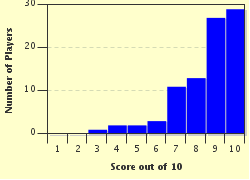Quiz Answer Key and Fun Facts
1. In the world of massage, what do the initials ART stand for?
2. What is the ultimate aim in acupressure?
3. Aquatherapy was particularly useful for people afflicted by which terrible epidemic of the 20th century?
4. Ashiatsu is the practice of massaging a patient or client with which part of the human body?
5. Different areas on which part of the body are believed to correspond to different organs within the body?
6. From which hip-swaying place did the massage technique of lomilomi originate?
7. When it was introduced, is it true that the medical profession welcomed the massage therapy, myofascial release, with open arms - yes or no?
8. To which field of science, associated with Isaac Newton, could the massage technique of rolfing perhaps be related?
9. Swedish massage utilises five different strokes. These include petrissage, tapotement, friction, vibration - and what else?
10. What exfoliation process is done to the body during the Chinese massage treatment of Gua sha?
Source: Author
Creedy
This quiz was reviewed by FunTrivia editor
WesleyCrusher before going online.
Any errors found in FunTrivia content are routinely corrected through our feedback system.

